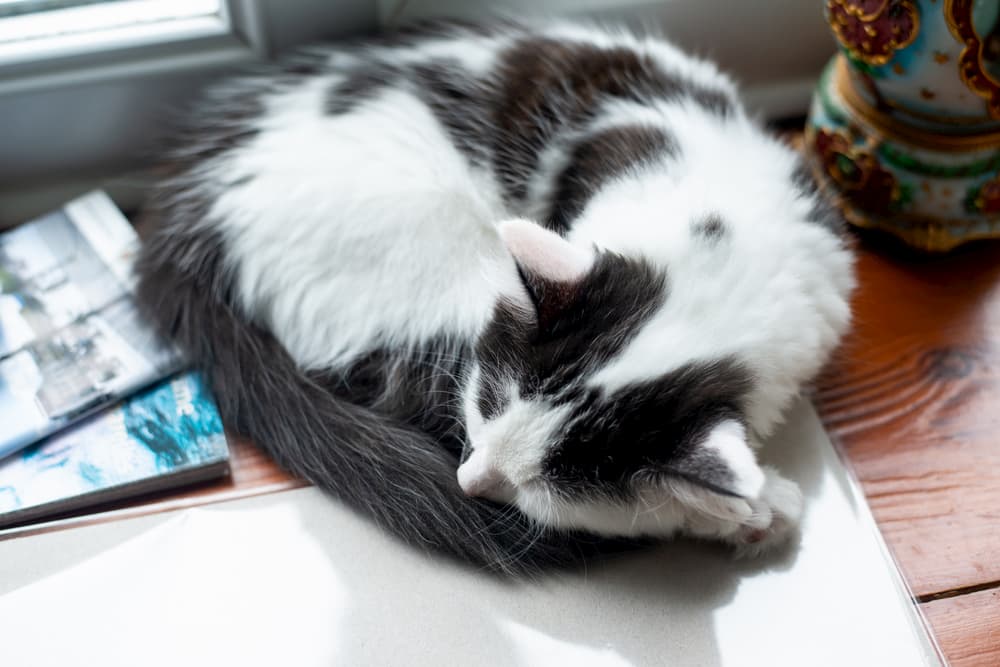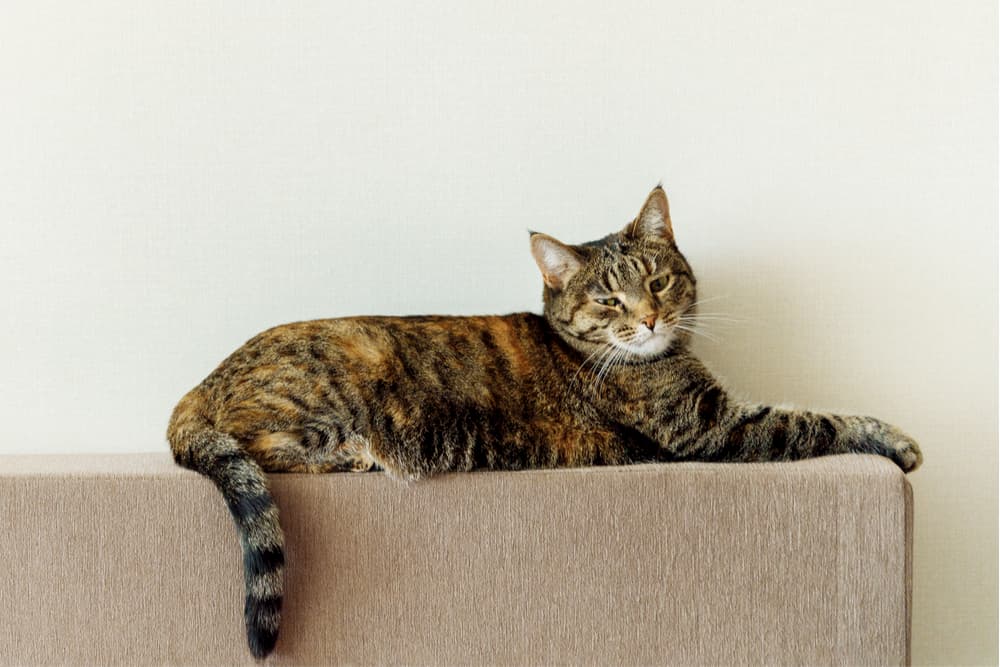Cat Tail Language: Decoding Your Feline’s Flick

People who do not understand cats falsely assume our feline friends are overly aloof. However, true cat lovers know just how expressive cats are.
Cats want to be understood, yet they speak an entirely different language than us humans, and their language is complex.
To deepen our bond with our cats and provide for their quality of life, we pet parents must become multilingual by learning cat tail language so we may “chat” with our cats.
Understanding Your Cat’s Tail: The Basics

A cat’s tail position is one way a cat communicates with humans as well as other cats and animals.
The long swishy tail of a feline is an important structure. The tail is a continuation of the spine, comprising between 18 to 20 caudal vertebrae in most domestic cat species. A cat’s tail anatomy is made up of fur, skin, bones, blood vessels, nerves, and a small amount of muscle. The nerve supply of a cat’s tail controls it in response to stimuli.
Some cat breeds are born with a shortened or absent tail (such as the Manx). Evaluating the behavior of these cat breeds is trickier since relying on tail positioning is not possible.
A cat’s tail does not function solely in communication. It is also important in balancing when running or jumping or as a counterbalance when a cat is walking on a narrow surface or suddenly changing direction when running or tracking prey. After all, cats are vertically-inclined creatures. When they’re not sleeping up to 18-20 hours per day, they’re often jumping and climbing, whether they’re in the wild or at home.
Cat Tail Health

A healthy tail is important to a cat’s overall wellbeing, and tail injuries can cause severe pain, discomfort, and stress for our cats.
Though the spinal cord itself ends before the tail, nerve damage to the tail (such as damage caused by tail pulling) can cause traumatic spinal injuries in cats. Tail fractures can also occur.
Severe or non-healing injuries to the tail may require amputation by a veterinarian. Fortunately, this surgical procedure is well-tolerated by the majority of cats.
Cat Tail Positions and What They Mean

Cats communicate in many ways. They vocalize by meowing and hissing, and they display non-verbal cues through body posture as well as eye and ear positioning.
Additionally, cat tails are very expressive, and the position of your cat’s tail is another method by which your kitty can “speak” to you—communicating his preferences, emotions, and even signs of illness or injury.
So what exactly are all your domestic cat’s different tail positions trying to tell you? Here’s a helpful breakdown.
Standing Straight Up

A cat with an upright tail pointing towards the sky is a happy feline. This tail position is similar to a human smile. A tail that stands straight up is a common greeting display, revealing that a cat is confident, content, and willing to interact with other cats or humans.
Amicable cats with this tail posture show other felines they are non-confrontational, reducing the possibility of a conflict.
You may also notice that the tip of the tail may rapidly quiver or buzz while in this upright posture, indicating that your cat is particularly joyful. Pet parents should reward these happy kitties with attention and praise.
The Curled Question Mark
Depending on their surroundings, cats with a hooked or bent tail resembling a question mark may be feeling either playful or otherwise doubtful. If something stressful is occurring, give your cat some time to gauge the situation. If your cat seems comfortable, try to encourage play with a dangly feather toy.
Curled Around the Body

If your cat’s tail is curled around itself while seated, your cat may be feeling submissive or a bit nervous. Give your cat some space to act on his own accord when ready. If your cat’s tail is curled around itself while he is sleeping, your cat needs a break and prefers to be left alone.
Wrapped Around You or Another Pet
Cats may also curl their tails around the body or tail of another cat as a sign of friendship and affection. You may notice that when your cat is especially relaxed in your presence, he may wrap a tail around your arm. This is your cat’s way of saying, “I love you.”
A Loose, Wagging Tail

If your cat’s tail is loosely and slowly swaying from side to side, your kitty is focusing intently on something, is bored, or is otherwise feeling playful and feisty. He may be preparing to stalk or pounce on prey, a toy, or a bit of food. Cat parents should allow their cats to continue to focus on whatever is holding their attention.
You may also notice that your cat may gently swish his tail when napping, meaning that this kitty is resting yet is remaining alert to what’s happening in the environment. Sometimes, a feline in a deep sleep may swish his tail when dreaming.
The Quick Flick

While a loosely wagging tail can be a sign of focus or playfulness, a rapidly whipping tail that is lashing from side to side more forcefully is a clear indicator that your feline friend is feeling fearful or aggressive.
A quick flick of the tail is a warning to other cats and humans to back off. These cats are agitated and may become aggressive if stressed further. The stronger the movement, the stronger the emotion. Pet moms and dads should back off and allow their cats to retreat. Avoid petting your cat to prevent petting-induced aggression.
Tail Held Straight Back
Depending on the circumstances, a cat holding its tail straight back may be either relaxed, slightly concerned, or else interested in something. Some cats that hold their tails down, especially at a 45-degree angle, may be feeling serious, somber, and slightly suspicious. However, for other kitties (particularly long-haired cat breeds such as Persians), a tail held back or down can be interpreted as a relaxed, neutral expression.
Always look for context based on your cat’s surroundings, body posture, eyes, and ear position to determine what your cat is sensing.
Tucked Tail

When your cat is frightened or submissive, he may tuck his tail tightly around the body or between the legs. Your cat may attempt to shrink to the smallest possible size, lowering his head and crouching his body. Cat guardians should try to reduce the source of their cat’s stress or insecurity and avoid upsetting the situation further.
Furthermore, a cat with a tucked tail may be experiencing pain. If in doubt, consult your veterinarian to ensure your feline companion does not have an illness or injury causing this behavior.
Puffed-Up Tail
While some cats may act submissive in the face of danger, other situations may require a cat to defend itself. In an attempt to look as large as possible to ward off a predator or other threat, your cat may bluff by bristling its hair through a smooth muscle action known as piloerection, causing the tail to puff up.
When your cat is this agitated or frightened, his back may also arch up to resemble a “Halloween cat” or “scaredy cat” posture—another means of appearing larger.
When your cat is afraid enough to be bristling his fur, you should carefully try to diffuse the distressing situation and avoid triggering your cat further, allowing your cat to retreat to avoid escalating the situation.
Your Cat’s Tail Language: Look for Context

Feline body and tail language is complex, but with a bit of practice, you’ll be on your way to becoming quite the pet interpreter. If ever in doubt of the meaning behind your cat’s tail position, look at other cues for indications of intent.
Here are some helpful hints and questions to ask:
Vocalization: Is your cat vocalizing by pleasantly purring or growling in anger or distress?
Overall posture: What is his body posture: relaxed, cowering, or about to pounce or attack?
Your cat’s eyes: Are his eyes soft and blinking, suggestive of a calm mood, or are they open wide and staring, more likely to be interpreted as alert, fearful, or aggressive?
Your cat’s ears: What about your cat’s ears? Are they relaxed and forward-facing or else aimed backward to suggest an irritated or angry feeling?
Any non-verbal feline behavior is best interpreted with what is happening in the environment and the overall appearance and actions of your cat. Full understanding is best gained by pairing together all these observations to decode how your cat is feeling.
By paying attention to your cat’s non-verbal cues such as tail positions, you’ll be fluent in feline language in no time and better able to understand and communicate with your furry best friend.









